Nishiki Market, a lively and iconic destination, is a must-visit when in Kyoto. With a rich history spanning over 400 years, this bustling marketplace is often called “Kyoto’s Kitchen” for good reason. It’s where the local community gathers to buy fresh ingredients, handmade crafts, and unique Kyoto-specific products. Whether you’re a foodie or a culture lover, Nishiki Market offers a one-of-a-kind experience blending tradition, culinary delights, and sensory overload.
What makes it truly special is its seamless mix of centuries-old traditions with modern life, offering a vibrant feast of local flavors, handcrafted goods, and authentic Kyoto experiences.
History and Background: From Fish Market to Food Paradise
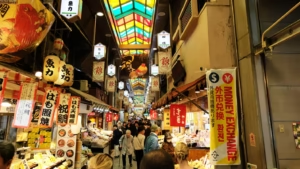
Photo from https://d1s09xku4jkn9v.cloudfront.net
Nishiki Market’s history dates back to the 1300s, when it began as a modest fish market. Over the centuries, it grew and transformed into a vibrant hub for food lovers. As Kyoto’s culinary scene evolved, the market adapted, catering to the needs of the city’s residents and chefs. It earned its well-known nickname, “Kyoto’s Kitchen,” due to its vital role in supplying fresh, local ingredients to restaurants and homes throughout the city.
Today, Nishiki Market remains a cornerstone of the community, combining rich tradition with modern trends. Visitors can still find traditional foods alongside contemporary offerings, creating a dynamic mix of old and new. The market has successfully preserved its historical charm while embracing innovation, making it a must-visit destination for both locals and tourists alike. Whether you’re shopping for ingredients or simply enjoying the atmosphere, Nishiki Market offers an authentic taste of Kyoto’s culinary heritage.
The Layout of Nishiki Market: A Culinary Maze to Explore
Navigating through Nishiki Market is like embarking on a food lover’s dream. The market’s narrow, covered street stretches for about five blocks, lined with over 100 vibrant shops. As you wander, you’ll pass fresh food vendors selling everything from seafood to pickled vegetables, traditional shops offering handcrafted goods, and souvenir stalls with Kyoto-specific treasures. The atmosphere is alive with the sounds of vendors calling out their specialties and the enticing aromas of fresh ingredients and sizzling street food.
Must-Products: Taste the Best of Kyoto
Here’s your list of must-try vendors and products in Nishiki Market, now in a table format with explanations of why they’re a must-try and how best to enjoy them:
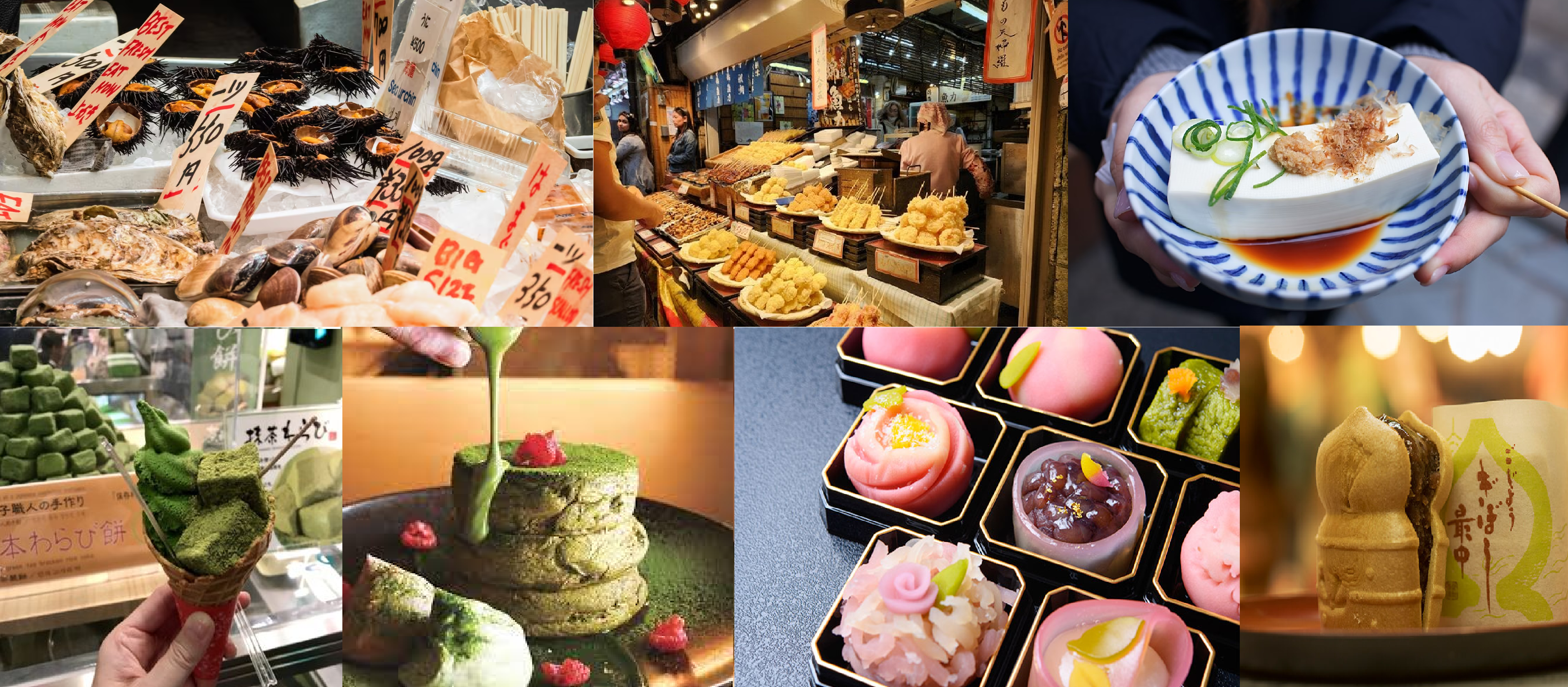
Photo from various websites
| Food Item | Why It’s a Must-Try | How to Best Eat It |
| Fresh Seafood and Seaweed | Kyoto’s seafood is fresh and delicately prepared, offering a taste of local heritage. | Try it on its own, or pair with a bowl of rice or pickled vegetables for a full experience. |
| Yudofu (Tofu Hot Pot) | Yudofu is a Kyoto specialty, showcasing the delicate flavor of tofu in a soothing broth. | Enjoy it hot from the pot, dipped in a light soy sauce or served with vegetables for a balanced meal. |
| Pickled Tofu | This item brings out the tangy side of tofu, perfect for those who love pickled foods. | Eat it as a snack, or pair it with a bowl of rice for an extra punch of flavor. |
| Matcha-Flavored Sweets | Kyoto is the birthplace of matcha, and these sweets offer a perfect balance of bitterness and sweetness. | Savor with a cup of fresh green tea to enhance the flavor contrast. |
| Kamonji Roasted Chestnuts | These seasonal treats are roasted fresh and packed with sweet, nutty flavor—perfect for autumn. | Eat them warm for the best experience, and don’t forget to peel the skin before enjoying. |
| Wagashi (Traditional Sweets) | Wagashi are beautifully crafted and reflect the seasons, offering a truly authentic Kyoto experience. | Enjoy these delicate sweets slowly, savoring the balance of textures and flavors with each bite. |
Why Try Them?
Each of these items offers a unique and authentic taste of Kyoto’s culinary traditions. From the fresh seafood to the delicate tofu and seasonal chestnuts, they represent the essence of local flavors, often rooted in centuries-old recipes. Whether you’re visiting in the spring for cherry blossom-inspired wagashi or in autumn for roasted chestnuts, Nishiki Market’s food is a reflection of Kyoto’s deep connection to nature and tradition.
How to Best Eat Them?
Many of these items are best enjoyed with local accompaniments, like a cup of green tea or a bowl of rice. Don’t rush—take your time and savor each bite. The vendors at Nishiki Market also provide plenty of opportunities to enjoy these delicacies right on the spot, so make sure to pause and appreciate the flavors in the vibrant market atmosphere.
The Art of Japanese Street Food at Nishiki
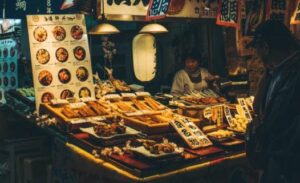
.Photo from https://www.agoda.com
Nishiki Market is not just for shopping—it’s a food lover’s paradise, especially for those who love Japanese street food. As you wander through the narrow alleys of the market, you’ll encounter a variety of sizzling treats that showcase the flavors of Kyoto and beyond. Here are some of the must-try street food offerings:
- Grilled Skewers (Kushiyaki): These skewers feature everything from tender chicken to grilled vegetables, all marinated in savory sauces and cooked over an open flame.
- Tempura: Light and crispy, tempura at Nishiki Market is often served fresh and hot, with ingredients like shrimp, seasonal vegetables, and sometimes even sweet potatoes, perfectly fried in a light batter.
- Okonomiyaki (Japanese Pancakes): A delicious savory pancake filled with cabbage, meat, or seafood, and topped with okonomiyaki sauce, mayonnaise, and bonito flakes—this is a street food staple in Japan.
- Taiyaki: A fun, fish-shaped pastry filled with sweet fillings like red bean paste or custard. It’s the perfect grab-and-go treat.
- Takoyaki: These savory, ball-shaped delights are made of batter, octopus, and tempura bits, drizzled with sauce and topped with bonito flakes.
5 Tips on Dining Etiquette in the Market
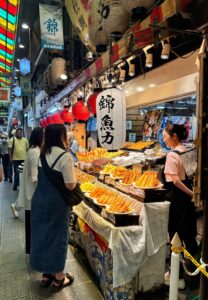
Photo from https://sjmcjapan.com
When indulging in street food at Nishiki Market, it’s important to be mindful of the local dining etiquette. Here are some tips to ensure a smooth experience:
- Polite Eating: While eating in public, try not to be overly noisy or slurp loudly, even with hot soup or noodles. Keep your eating pace moderate and enjoy your food without rushing.
- Dispose of Waste Properly: Always clean up after yourself. Make sure to use the designated bins for waste, as it’s important to respect the market and its community.
- Paying with Cash: Most of the stalls prefer cash, so have yen ready. Be sure to handle money politely—using both hands when passing money is considered respectful.
- Don’t Walk and Eat: While it’s common to grab food and walk, try to find a nearby spot to stand and eat, rather than walking around with food in hand.
- Respect Vendors: Kyoto is known for its polite and humble people, so show respect to the vendors. If you have any questions, feel free to ask—but be polite when doing so.
Enjoying street food at Nishiki Market is all about experiencing the true flavors of Kyoto while respecting its local customs. So take your time, savor each bite, and enjoy the lively atmosphere!
Local Culture and Traditions: A Taste of Kyoto’s Heritage
Nishiki Market is more than just a place to shop—it’s a living representation of Kyoto’s rich culture and culinary heritage. As you stroll through the market, you’ll find that every product and every vendor tells a story of tradition, craftsmanship, and a deep connection to the past.
Traditional Kyoto Ingredients
Nishiki Market is a living tribute to Kyoto’s culinary history. From handmade pickles to locally produced tofu, the market offers an array of traditional ingredients that have been integral to the city’s food culture for centuries. The quality and craftsmanship of these products reflect the deep-rooted traditions of Kyoto’s culinary scene.
The Vendors’ Hospitality
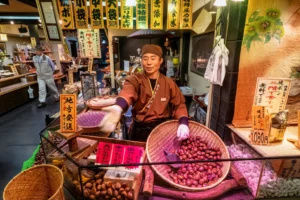
Photo from https://www.touristjapan.com
It’s not just about the food—Nishiki Market is also known for its warm, welcoming vendors. These artisans are passionate about their products and are happy to share their knowledge with visitors. Their genuine hospitality adds an authentic touch to the market experience, making you feel as if you’ve stepped into the heart of Kyoto’s food culture.
A Connection to Kyoto’s Food Culture
For locals, Nishiki Market is a central part of daily life. It provides the essential ingredients for preparing traditional dishes like kaiseki and yudofu. By keeping these culinary practices alive, the market connects the people of Kyoto to their heritage and ensures that ancient food traditions are passed down through generations.
A Window Into Kyoto’s Past and Present
For visitors, Nishiki Market offers a rare opportunity to experience Kyoto’s culture through its food, its products, and its people. It’s a place where history and modern life seamlessly blend, giving a unique glimpse into the timeless traditions and vibrant energy of this culturally rich city.
Practical Information: Your Nishiki Market Checklist
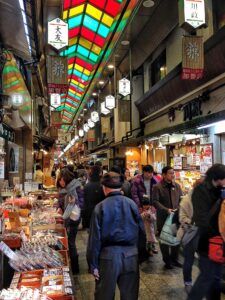
Photo from https://foodicles.com
Nishiki Market, often referred to as “Kyoto’s Kitchen,” is a 400-meter-long shopping street lined with over 100 shops and stalls offering a variety of local foods and goods. Here’s some practical information to help you plan your visit:
- Address: 609 Nishidaimonjicho, Nakagyo Ward, Kyoto City, Kyoto Prefecture, 604-8054
- Phone: 075-211-3882
- Website: https://www.kyoto-nishiki.or.jp/
Getting There:
Nishiki Market is centrally located in Kyoto’s Nakagyo Ward, making it easily accessible via public transportation:
- By Subway: The market is a short walk from the Karasuma-Oike Station (served by the Karasuma and Tozai Lines) and Shijo Station (Karasuma Line).
- VIa Bus: Kyoto City Bus lines 9, 50, and 101 stop near the market, with the “Shijo Kawaramachi” stop being the closest.
- On Foot: If you’re staying in central Kyoto, the market is within walking distance from popular areas like Gion and Pontocho.
Business Hours:
While Nishiki Market as a whole doesn’t have a designated closing day, individual shop hours can vary. Many shops are closed on Wednesdays. It’s advisable to check the operating hours of specific shops you’re interested in visiting.
Please take notes of the following details from their website:
- Peak Hours: The market can get crowded, especially during weekends and holidays. Visiting on weekdays may offer a more relaxed experience.
- Walking and Eating: To maintain a respectful atmosphere, it’s requested that visitors refrain from eating while walking. Enjoy your purchases inside the shops or at designated seating areas.
- Parking: If you’re traveling by car, there’s a parking facility called “Amicale Nishiki” located on the west side of Tominokoji Shijo-Agaru. Operating hours are from 10:00 AM to 5:00 PM, with a vehicle capacity of 14 units.
Tips for Visiting Nishiki Market: Make the Most of Your Experience
Nishiki Market is a must-visit spot, but to get the best experience, here are a few tips to help you navigate the market like a local.
Best Times to Visit for Fewer Crowds
If you prefer a more peaceful experience without the crowds, the best times to visit Nishiki Market are early mornings or weekdays. Arriving before the midday rush allows you to take your time exploring the stalls and savoring the flavors without feeling rushed.
Early mornings also offer the chance to see the market at its freshest, with many vendors just setting up for the day.
Navigating the Market: 3 Tips for a Smooth Visit
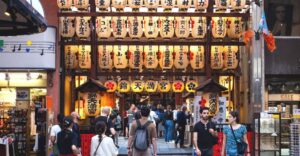
Photo from https://powertraveller.com
Nishiki Market can get busy, so here are some tips for a smoother visit:
- Cash is King: Most vendors prefer cash payments, so be sure to have yen on hand. While some shops may accept credit cards, cash is always the safest bet.
- Popular Photo Spots: Don’t miss snapping a photo of the colorful displays of fresh produce, dried fish, or the vibrant matcha sweets. The narrow alleys and old wooden stalls also make for beautiful backdrops.
- Polite Behavior: Keep in mind that the market is a local space. Be respectful by walking at a steady pace, refraining from loud conversations, and not blocking narrow walkways. Asking vendors before sampling goods is always appreciated.
Accessibility for Tourists with Limited Japanese Language Skills
Don’t worry if you’re not fluent in Japanese—Nishiki Market is tourist-friendly! Many vendors have signs in English, and a lot of the staff can communicate basic phrases. Additionally, the market’s welcoming atmosphere makes it easy to ask for help if needed. Some shops even provide English menus, and with a little patience, you’ll find it easy to navigate.
3 Nearby Attractions: Keep the Adventure Going
Once you’ve explored the market, there are plenty of nearby attractions to continue your cultural journey.
1. Gion District
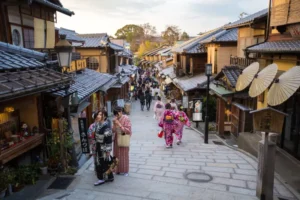
Photo from travel.rakuten.com
A short walk from Nishiki Market, Gion is Kyoto’s most famous geisha district, known for its traditional wooden teahouses and stunning architecture. After the lively market, Gion offers a peaceful and nostalgic atmosphere, perfect for a stroll. The district is an excellent spot for spotting geishas or enjoying the charm of old Kyoto, especially at sunset when the lanterns illuminate the streets
Explore Gion at Gionmachi, Higashiyama Ward, Kyoto, 605-0074, Japan.
2. Nishiki Tenmangu Shrine
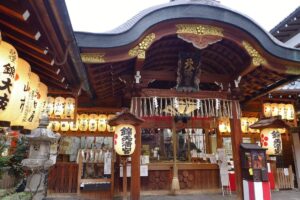
Photo from https://images.squarespace-cdn.com
Located just near Nishiki Market, this small shrine is dedicated to Sugawara no Michizane, the god of learning. A peaceful escape from the busy market, the shrine offers a quiet atmosphere with beautiful traditional architecture. It’s a great spot for reflection and experiencing Kyoto’s spiritual side.
- Address: 537 Nakanocho, Nakagyo Ward, Kyoto, 604-8042, Japan
- Phone: 075-231-5732
- Website: https://nishikitenmangu.or.jp/
- Admission Fee: No admission fee to enter the shrine grounds, but visiting the plum garden costs ¥700 for adults and ¥350 for children.
- Business Hours: Daily, 8:00AM – 8:00PM
3. Pontocho Alley
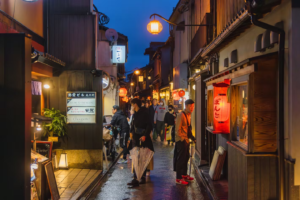
Photo from https://waybird.imgix.net
Pontocho Alley is a scenic, narrow street along the Kamogawa River, lined with traditional restaurants and bars. After enjoying Nishiki Market, head to Pontocho for more Kyoto cuisine in a picturesque riverside setting. The area is also known for its vibrant nightlife, making it a perfect place to relax and enjoy Kyoto’s culinary delights.
Navigate around Pontocho 145 Umenokicho Nakagyo Ward, Kyoto, 604-8002, Japan
Nishiki Market is Beyond the Bites: Savoring Kyoto’s Kitchen is Worth the Trip
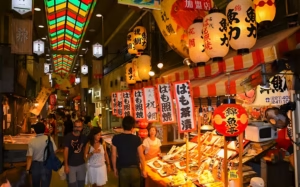
Photo from https://headout.com
Nishiki Market is more than just a food destination—it’s a gateway to experiencing the true essence of Kyoto. As you wander through the vibrant aisles, you’re not only sampling delicious local flavors but also immersing yourself in the city’s rich cultural heritage. The market, known as “Kyoto’s Kitchen,” offers a firsthand look at the culinary traditions that have shaped the city for centuries. Beyond its wide variety of fresh ingredients, local specialties, and street food, Nishiki Market invites visitors to connect with the heart of Kyoto’s everyday life.
With its friendly vendors, historical atmosphere, and unique charm, the market is an essential stop for any traveler seeking a deeper understanding of Kyoto. Whether you’re a food lover or a cultural enthusiast, Nishiki Market provides an unforgettable experience that captures the spirit of the city.
Frequently Asked Questions (FAQs)
How long should I spend at Nishiki Market?
A typical visit to Nishiki Market lasts around 1-2 hours, depending on how much time you want to spend exploring the various stalls, tasting food, and shopping for local products.
Is Nishiki Market suitable for children?
Yes, Nishiki Market is family-friendly. Kids will enjoy the colorful displays of food, street treats like taiyaki, and the lively atmosphere.
Can I find souvenirs at Nishiki Market?
Absolutely! Nishiki Market offers a range of unique Kyoto-specific souvenirs, such as handmade crafts, local teas, spices, and even specialty kitchenware.
Are there restrooms available at Nishiki Market?
Yes, public restrooms are available near the entrance of the market. Some of the nearby shops may also provide restrooms for customers.
Can I sample food before buying it?
In general, it’s common to sample food before purchasing, but always ask the vendor politely first. S
Can I find vegan or vegetarian options at Nishiki Market?
Yes, there are plenty of vegetarian and vegan options available, especially with Kyoto’s famous yudofu (tofu hot pot), pickled vegetables, and plant-based sweets. Be sure to ask the vendors if you have specific dietary preferences.
Is Nishiki Market accessible to people with disabilities?
Nishiki Market can be a bit challenging for people with disabilities due to its narrow, crowded aisles and the lack of dedicated ramps in some areas. However, there are some accessible features, such as wider entrances at certain points and ground-level access.

